March Chicago Board of Education meeting hears from dozens of angry parents, teachers
Two into one won't go, was one way long division was once taught. Well, two into one must go, when "consolidation" of schools in Chicago is one of the topics, as it was at the March 2011 Chicago Board of Education (BOE) meeting. The meeting was held at 125 S. Clark Street on Wednesday, March 23, 2011, in the Board Chambers on the fifth floor of the Loop building. A half dozens schools — represented by teachers, parents, and others — told the Board members about how their public schools were being undermined or destroyed by the Board's "consolidation" and other policies. Not one Board member asked a serious question, although the destruction of children's lives from the west side through the southeast side was documented for everyone to see and hear.
And as far as Chicago's corporate media (now including The New York Times) were concerned, the main story of the day was about a program called "Breakfast in the Classroom" and about repeating, without one critical question or careful look at history, the annual Board lie that it has a huge "deficit" in next year's budget.
In other words, for both the seven members of the Chicago Board of Education and for the reporters who cover Board activities, it was business as usual.
 Araceli Gonzalez-Mancilla (above in red coat) helped lead the protests in front of 125 S. Clark St. before the March 23, 2011 meeting of the Chicago Board of Education. Despite lies told to the public by CEO Terry Mazany and the vicious hostility of Board President Mary Richardson Lowry, the Whittier "Moms" continued their protests to get a library in La Casita. The sign above refers to the fact that CPS is resuming closing and consolidating schools, which was one of the reasons Whittier was squeezed. When CPS closed nearby De La Cruz Middle School, claiming it was not needed, Whittier was converted from a space available K-5 school into an overcrowded K-8 school, the deliberate sabotage resulting from Board policy. At the March 23 meeting, the Board continued the same consolidation policies. Substance photo by George N. Schmidt.The meeting began with the usual "good news" announcements by Chicago Board of Education President Mary Richardson-Lowry. Among some of the announcements made were the shadow student and the student of the month and the Whitney Young Magnet High School Chess Team winners and Academic Decathalon Winners. The Whitney Young Magnet High School Chess Team took first place in the state out of 128 teams. Their previous championship win was in 1988.
Araceli Gonzalez-Mancilla (above in red coat) helped lead the protests in front of 125 S. Clark St. before the March 23, 2011 meeting of the Chicago Board of Education. Despite lies told to the public by CEO Terry Mazany and the vicious hostility of Board President Mary Richardson Lowry, the Whittier "Moms" continued their protests to get a library in La Casita. The sign above refers to the fact that CPS is resuming closing and consolidating schools, which was one of the reasons Whittier was squeezed. When CPS closed nearby De La Cruz Middle School, claiming it was not needed, Whittier was converted from a space available K-5 school into an overcrowded K-8 school, the deliberate sabotage resulting from Board policy. At the March 23 meeting, the Board continued the same consolidation policies. Substance photo by George N. Schmidt.The meeting began with the usual "good news" announcements by Chicago Board of Education President Mary Richardson-Lowry. Among some of the announcements made were the shadow student and the student of the month and the Whitney Young Magnet High School Chess Team winners and Academic Decathalon Winners. The Whitney Young Magnet High School Chess Team took first place in the state out of 128 teams. Their previous championship win was in 1988. 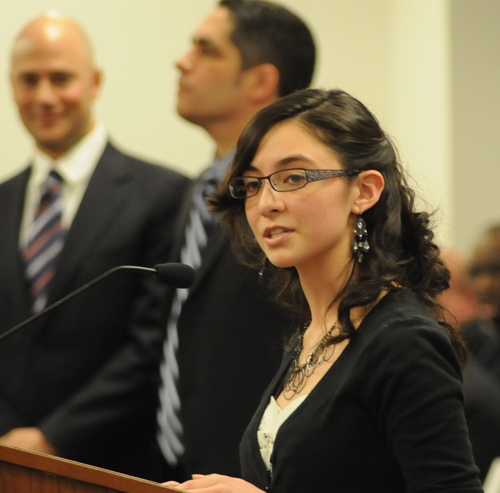 Mazany's two presentations, which followed quickly after the 'good news' time wasters, were clearly upstaged by the students from Whitney Young's decathlon team. Substance photo by George N. Schmidt.One of Whitney Young's Magnet High School's Decathalon students received "perfect," a first in Decathalon history.
Mazany's two presentations, which followed quickly after the 'good news' time wasters, were clearly upstaged by the students from Whitney Young's decathlon team. Substance photo by George N. Schmidt.One of Whitney Young's Magnet High School's Decathalon students received "perfect," a first in Decathalon history.
After the roll call and Pledge of Allegiance, Dr. Charles Payne was introduced as the new Chief Education Officer, replacing Barbara Eason-Watkins as the Chief Education Officer. The last meeting of Barbara Eason-Watkins had been in June 2010, so the Board had waited the better part of a year before replacing its "Chief Education Officer." Many observers, including leaders of the Chicago Teachers Union, had said that the lengthy delay was an indication of how business people had taken over the Chicago school system, and how educators were denigrated. Dr. Payne, from the University of Chicago, was not a Chicago public schools educator either.
The meeting then began with three presentations by the Chief Executive Officer.
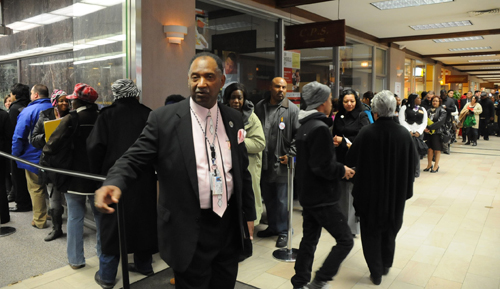 As the President of the Chicago Board of Education, politically connected lawyer Mary Richardson Lowry, began the meeting of the Board on the fifth floor of 125 S. Clark St. on March 23, 2011, Board security continued to bottle more than 100 people who had come down town, some as early as 6:00 a.m., to speak to the Board. Meanwhile, upstairs on the fifth floor, the Board had reserved additional seats for its bureaucrats, and on the 15th floor Substance counted more than 140 empty seats while the crowd in the lobby grew restless. Substance photo by George N. Schmidt.One that was to resonate the rest of the day was about the so-called "Breakfast in the Classroom" program that CEO Terry Mazany had approved and begun implementing two months earlier. The controversial program has faced mounting criticism from parents, teachers, and principals because it pretends to be able to serve a "breakfast" to all children during the first ten minutes of class during the school day. Nobody to our knowledge has been critical of feeding children before school; the issue had been (and continued to be) the notion that the feeding could be done outside the lunchroom in thousands of classrooms, and the claim that the whole thing could be accomplished in only ten minutes.
As the President of the Chicago Board of Education, politically connected lawyer Mary Richardson Lowry, began the meeting of the Board on the fifth floor of 125 S. Clark St. on March 23, 2011, Board security continued to bottle more than 100 people who had come down town, some as early as 6:00 a.m., to speak to the Board. Meanwhile, upstairs on the fifth floor, the Board had reserved additional seats for its bureaucrats, and on the 15th floor Substance counted more than 140 empty seats while the crowd in the lobby grew restless. Substance photo by George N. Schmidt.One that was to resonate the rest of the day was about the so-called "Breakfast in the Classroom" program that CEO Terry Mazany had approved and begun implementing two months earlier. The controversial program has faced mounting criticism from parents, teachers, and principals because it pretends to be able to serve a "breakfast" to all children during the first ten minutes of class during the school day. Nobody to our knowledge has been critical of feeding children before school; the issue had been (and continued to be) the notion that the feeding could be done outside the lunchroom in thousands of classrooms, and the claim that the whole thing could be accomplished in only ten minutes.
Instead of addressing the critics of the program, Mazany instead called on an outsider to report on how much hunger there was in Chicago among children. Information about Breakfast in the Classroom and Food Safety were then presented. A report from the Greater Chicago Food Depository, the largest food depository in the country, stated that sixty-six million pounds of food was distributed last year and the great need for nourishment, especially by children was mentioned. In 1966, the school breakfast program began, but is under-utilized in Chicago, leading to the present introduction of the Breakfast in the Classroom and Universal Breakfast programs, which are expected to lead to higher academic achievement.
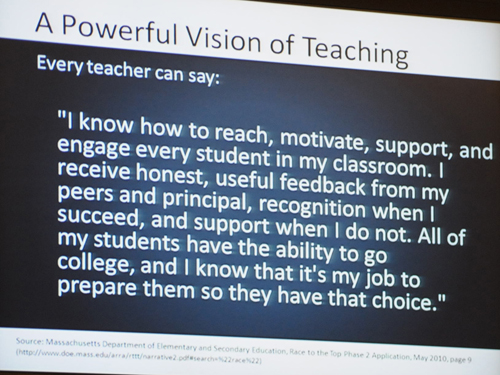 Terry Mazany's vision for what a 'teacher' should say was taken from the "Race to the Top" application of the Massachusetts. Like most of what Mazany presented as a strategic vision for Chicago's public schools, the material was derivative w recycled and widely discredited neoliberal bullshit. Substance photo by George N. Schmidt.Chief Executive Officer (CEO) Terry Mazany then began a Power Point presentation on Education Planning. Among the Education Plan topics were Aiming Higher, An Education Vision for CPS students, Strategic Guidance, Our Vision for Student Learning, Student Success for the Twenty-First Century, Characteristics of High-Performing Schools, Alignment of the Central Office with the Area, Schools Parents and Community, Design Principles to Improve Schools, Common Core State Standards Initiatives, Design Principles Regarding Continuous Improvement, Capacity of the Building and Equity, Key Recommendations, Essential Questions, and Organization: A Powerful Vision of Student Learning, Instruction and Assessment.
Terry Mazany's vision for what a 'teacher' should say was taken from the "Race to the Top" application of the Massachusetts. Like most of what Mazany presented as a strategic vision for Chicago's public schools, the material was derivative w recycled and widely discredited neoliberal bullshit. Substance photo by George N. Schmidt.Chief Executive Officer (CEO) Terry Mazany then began a Power Point presentation on Education Planning. Among the Education Plan topics were Aiming Higher, An Education Vision for CPS students, Strategic Guidance, Our Vision for Student Learning, Student Success for the Twenty-First Century, Characteristics of High-Performing Schools, Alignment of the Central Office with the Area, Schools Parents and Community, Design Principles to Improve Schools, Common Core State Standards Initiatives, Design Principles Regarding Continuous Improvement, Capacity of the Building and Equity, Key Recommendations, Essential Questions, and Organization: A Powerful Vision of Student Learning, Instruction and Assessment.
A fiscal year 2012 budget overview, which was labeled a "draft — not for distribution," was then presented (and distributed to the press). According to Mazany, the deficit is expected to be $700 million. There were, as usual, no questions from the members of the Board of Education about the numbers that will now play such an important role in school policy.
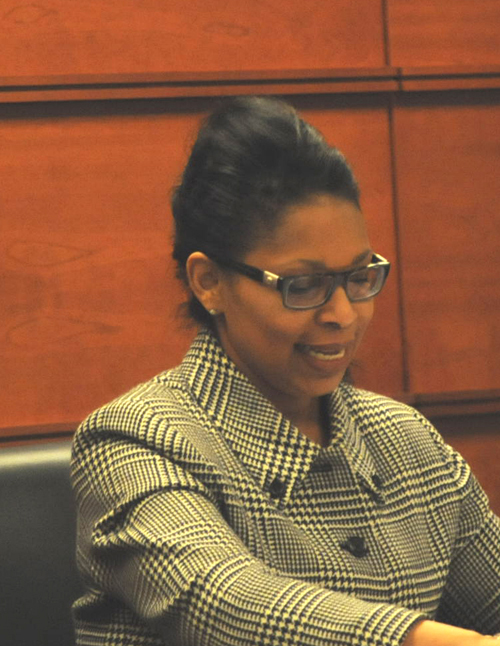 Chicago Board of Education president Mary Richardson Lowry (above during the March 23 Board meeting) continued her program of stalling the public participation portion of the Board by scheduling a half dozen events and three reports before allowing the public participation to begin. Richardson-Lowry's increasingly dictatorial approach to the open meetings the Board is supposed to be holding has resulted in increasing criticism from parents, teachers, and community leaders. Nevertheless, at the March 23 meeting she proudly announced that in April she would propose rules that everyone expects will further restrict the ability of parents, students and teachers to participate in Board meetings. Substance photo by George N. Schmidt.Before the public participation finally began just before noon, there was a somewhat shocking announcement. Board President Mary Richardson Lowry, who has shown the greatest bias against public participation in the recent history of the Board, has demanded that the rules for public participation be revised. The Board announced that the present policy on public participation, set up in 2004, is expected to be changed today in closed session — and new guidelines will be published prior to the April Board meeting on April 27. The 2004 guidelines will still apply today.
Chicago Board of Education president Mary Richardson Lowry (above during the March 23 Board meeting) continued her program of stalling the public participation portion of the Board by scheduling a half dozen events and three reports before allowing the public participation to begin. Richardson-Lowry's increasingly dictatorial approach to the open meetings the Board is supposed to be holding has resulted in increasing criticism from parents, teachers, and community leaders. Nevertheless, at the March 23 meeting she proudly announced that in April she would propose rules that everyone expects will further restrict the ability of parents, students and teachers to participate in Board meetings. Substance photo by George N. Schmidt.Before the public participation finally began just before noon, there was a somewhat shocking announcement. Board President Mary Richardson Lowry, who has shown the greatest bias against public participation in the recent history of the Board, has demanded that the rules for public participation be revised. The Board announced that the present policy on public participation, set up in 2004, is expected to be changed today in closed session — and new guidelines will be published prior to the April Board meeting on April 27. The 2004 guidelines will still apply today.
Democracy was clearly not going to be on the agenda. In addition to continuing to hold the meetings of the Board of Education only once a month during "bankers hours," Richardson Lowry has also continued the practice of holding Board meetings at the Board's downtown headquarters, cynically guaranteeing that most working class people can never attend the meetings, and that poor people, who can't afford parking in the privatized Loop, are excluded from almost all participation in the supposedly public meetings of their school board.
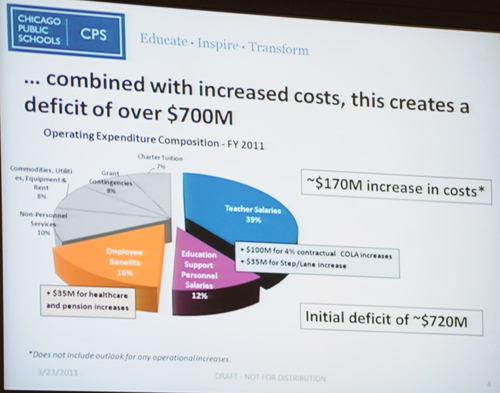 Mazany's inaccurate budget numbers were once again presented to the Board and the public via the corporate media without any critical questions being asked. On Mazany's orders, Board communications chief Monique Bond excluded Substance from Mazany's media event that was held an hour before the March 23 Board meeting. For three years, CPS officials have presented budget numbers that were completely inaccurate in order to create shock doctrine budget fears that could then give rise to a repeated "crisis." In 2010, the crisis reached new heights in the fictionalizations of financial information presented by Mazany's predecessor, Ron Huberman, resulting in attacks on both the Chicago Teachers Pension Fund and veteran Chicago teachers. Substance photo by George N. Schmidt.More than 80 percent of the children who attend Chicago's public schools are in poverty, but their voices are never heard by the millionaire bankers, doctors, lawyers, and corporate executives who sit on the seven-member Chicago Board of Education with Richardson Lowry.
Mazany's inaccurate budget numbers were once again presented to the Board and the public via the corporate media without any critical questions being asked. On Mazany's orders, Board communications chief Monique Bond excluded Substance from Mazany's media event that was held an hour before the March 23 Board meeting. For three years, CPS officials have presented budget numbers that were completely inaccurate in order to create shock doctrine budget fears that could then give rise to a repeated "crisis." In 2010, the crisis reached new heights in the fictionalizations of financial information presented by Mazany's predecessor, Ron Huberman, resulting in attacks on both the Chicago Teachers Pension Fund and veteran Chicago teachers. Substance photo by George N. Schmidt.More than 80 percent of the children who attend Chicago's public schools are in poverty, but their voices are never heard by the millionaire bankers, doctors, lawyers, and corporate executives who sit on the seven-member Chicago Board of Education with Richardson Lowry.
Observers from Substance noted, once again, that Richardson-Lowry had reduced the number of seats available for the public in the Board's fifth floor chambers, while as late as 10:30 a.m., more than 140 parents, students and teachers were still being forced to wait in line to go through the metal detectors in the lobby, while bureaucrats from CPS took up seats in the fifth floor chambers and more than 100 seats remained empty in the "holding room" on the 15th floor. Once the public participation began, the Board president immediately showed her biases by abruptly cutting off those who were critical of Board policies, while devoting lengthy time to those who supported even the most controversial Board policies. 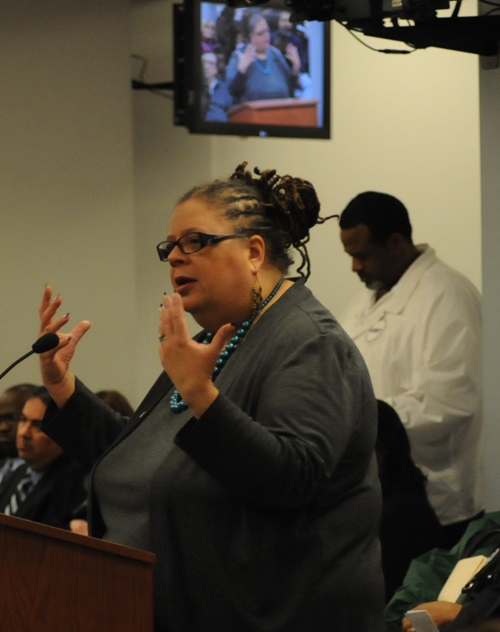 Chicago Teachers Union President Karen Lewis (above) tried unsuccessfully to remind the Board members and CEO Terry Mazany that the scheduling of closing hearings and Board actions in March and April was hurting children and possibly illegal under the legislation now in place governing facilities decisions in Chicago's public schools. Substance photo by George N. Schmidt.The rules for public participation for March 23 were then announced by President Richardson-Lowry. Misspeaking as she often does, she said: "Each speaker will be given two hours." A roar of surprise and apparent approval went up. She laughingly corrected the time limit to the usual two minutes per speaker. As usual, she emphasized the increasing restrictions on the ability of members of the public to speak critically, even for a brief two minutes, about Board policies and practices.
Chicago Teachers Union President Karen Lewis (above) tried unsuccessfully to remind the Board members and CEO Terry Mazany that the scheduling of closing hearings and Board actions in March and April was hurting children and possibly illegal under the legislation now in place governing facilities decisions in Chicago's public schools. Substance photo by George N. Schmidt.The rules for public participation for March 23 were then announced by President Richardson-Lowry. Misspeaking as she often does, she said: "Each speaker will be given two hours." A roar of surprise and apparent approval went up. She laughingly corrected the time limit to the usual two minutes per speaker. As usual, she emphasized the increasing restrictions on the ability of members of the public to speak critically, even for a brief two minutes, about Board policies and practices.
Karen Lewis, Chicago Teachers Union (CTU) President spoke first. She said we are here because of recent articles about school closings. Prior to 2011, CPS had always released its list of schools facing closing in January, with hearings prior to the February meeting of the school board. Now we were in March and Mazany was just getting around to announcing the 2011 'Hit List.' Lewis said that she wanted to know what support the Chicago Public Schools (CPS) will put in place for the affected students. She mentioned that transitioning from one school to another leads to a loss of about six months learning. She added that more advanced warning was promised, and that January was the usual announcement month. She concluded by saying that "trust is the true deficit we face here today" and that inferior buildings for neighborhood schools is not equitable with two million dollar campus parks for charter schools. She was referring to the fact that the Board was about to approve a plan to give the Beidler Elementary School to a new "campus" of "Urban Prep", while at the same time authorizing the expense to add a "campus park" to the Beidler site after years of neglect of the facility.
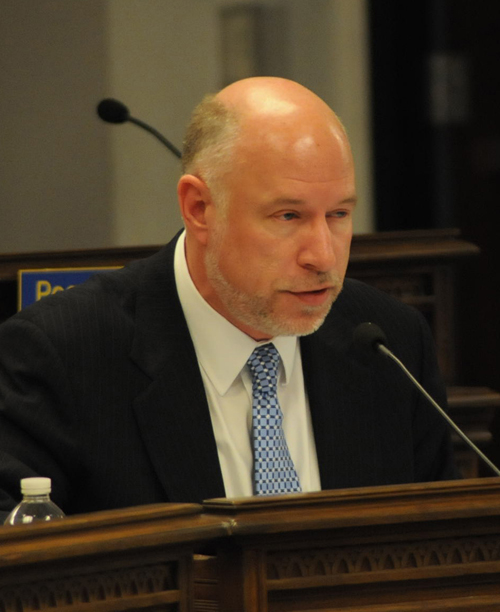 Terry Mazany's responses to the criticisms of Karen Lewis came out of the traditional social efficiency script that has been the playbook of Chicago Public Schools executives for more than a decade. Ignoring both state law (the facilities requirements) and the needs of children, Mazany is pushing through a number of school destructions prior to the end of the 2010 - 2011 school year. In most cases, the actions are to clear out public school children so that the buildings can be given to charter schools, among them 'Talent Development High School' (which is also hyping itself with the help of The New York Times) and the expanding Urban Prep (which hypes itself with the help of the Chicago Tribune). Substance photo by George N. Schmidt.CEO Mazany stated that when he began his current position in December 2010, things were done and left undone. He said that decisions are not being made today about all forty schools that were to be affected by consolidation. Those decisions were still under consideration.
Terry Mazany's responses to the criticisms of Karen Lewis came out of the traditional social efficiency script that has been the playbook of Chicago Public Schools executives for more than a decade. Ignoring both state law (the facilities requirements) and the needs of children, Mazany is pushing through a number of school destructions prior to the end of the 2010 - 2011 school year. In most cases, the actions are to clear out public school children so that the buildings can be given to charter schools, among them 'Talent Development High School' (which is also hyping itself with the help of The New York Times) and the expanding Urban Prep (which hypes itself with the help of the Chicago Tribune). Substance photo by George N. Schmidt.CEO Mazany stated that when he began his current position in December 2010, things were done and left undone. He said that decisions are not being made today about all forty schools that were to be affected by consolidation. Those decisions were still under consideration.
CTU President Lewis then said that the problem is with the process.
President Richardson-Lowry asked CTU President Lewis and CEO Mazany to "carve out" a meeting.
Alderman Urban of the 28th Ward and a member of the Local School Council (LSC) at Beidler School expressed concern about the consolidation of Beidler (with 400 students) into Cather (with 190 students). He remarked that it should be Cather to Beidler.
CEO Mazany responded that it is a difficult situation with three schools in two buildings.
Araceli Gonzalez-Mancilla, a parent at Whittier School, wants the fieldhouse at Whittier, named LaCasita, to be renovated and wants to meet with CEO Mazany, as did previous CEO Ron Huberman. She asked that the children be given the library they deserve. She asked that LaCasita be renovated - the money's there.
Gema Gaete said that there is $564,000 to renovate LaCasita, which was agreed upon previously. The library in the Whittier building is being used by the Special Education students. Ms Gaete asked that the field house be renovated, that Special Education not be pushed out and that the Board meet with us. She emphasized that there's no room in our school (for the library) and asked that the Board please answer us.
CEO Mazany replied that they have reviewed the situation with the principal. He added: "You've been successful." Two million in pledges was raised, he said, claiming again that there was no money in the budget, while ignoring the fact that millions of dollars have been going to charter schools while he spoke.
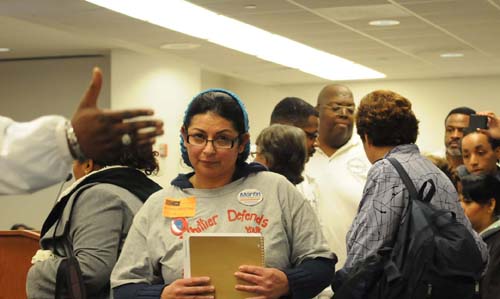 Once again at the March 23, 2011, meeting of the Chicago Board of Education, Board President Mary Richardson Lowry ordered CPS's large security staff to overwhelm the Whittier Moms and force them out of the Board chambers rather than answer the group's questions about why the Board continues to refuse to put the library inside La Casita. Richardson Lowry, a lawyer without any education experience and a protege of outgoing Mayor Richard M. Daley, has been hostile towards the Whittier parents since they began their criticisms of Board policies, and has ordered security agains them on several occasions since she was made Board President 14 months ago. Substance photo by George N. Schmidt.But the fundamental questions were not answered. Because CPS closed the nearby De La Cruz Middle School two years ago, Whittier currently doesn't have space inside the building for the library without displacing the space used for special education. When the Whittier parents demanded more answers, Board President Mary Richardson Lowry signaled Board security, and a half dozen large security people moved in on the women from Whittier.
Once again at the March 23, 2011, meeting of the Chicago Board of Education, Board President Mary Richardson Lowry ordered CPS's large security staff to overwhelm the Whittier Moms and force them out of the Board chambers rather than answer the group's questions about why the Board continues to refuse to put the library inside La Casita. Richardson Lowry, a lawyer without any education experience and a protege of outgoing Mayor Richard M. Daley, has been hostile towards the Whittier parents since they began their criticisms of Board policies, and has ordered security agains them on several occasions since she was made Board President 14 months ago. Substance photo by George N. Schmidt.But the fundamental questions were not answered. Because CPS closed the nearby De La Cruz Middle School two years ago, Whittier currently doesn't have space inside the building for the library without displacing the space used for special education. When the Whittier parents demanded more answers, Board President Mary Richardson Lowry signaled Board security, and a half dozen large security people moved in on the women from Whittier.
Matthew Johnson of the Dewey School expressed concern about the Principal Selection Process first. He remarked that we like the principal we have. He alluded to a child abuse case during the time of principal selection and remarked "Teachers are raping students. This information should have been given to us." He then talked about parent involvement, saying money is just sitting there, money was spent on fourteen positions, and asking when will the money be released?
President Richardson-Lowry suggested that two staff members meet with Matthew Johnson.
Georgette Greenlee Finney, the executive director of the Woodlawn Organization, wants continuation of the Culture of Calm Initiatives Funding in the 2012 budget. The treatment by the Board members and Mazany of Finney and those who turned out to praise "Culture of Calm" was in sharp contrast to the treatment, a few moments earlier, of the Whittier group.
In response to Finney and others, CEO Mazany replied that the District was a recipient of a one-time gift toward the Culture of Calm initiative. He added that CPS is pursuing supplemental funding and new resources, but that it may need to make painful cuts. He said Michael Shields, the CPS security chief and a relative of Michell Obama, is involved in the Culture of Calm program. Culture of Calm was initiated by President Obama following the widely publicized murder of Fenger High School student Derrion Albert in September 2009. Obama sent Education Secretary Arne Duncan and Attorney General Eric Holder to Chicago to announce that the federal government was providing CPS with a two-year grant of $65 million for the initiative. The money has now run out.
President Richardson-Lowry mentioned that funding ends at the end of the summer.
Sharon Banks, an LSC member at Harlan High School, expressed her thanks for the Culture of Calm. She said students also want to thank the Board. Forty-seven students had an opportunity to fly to Detroit on a twelve-hour field trip to visit Motown Records and the Wright Museum of African-American History. Tanya Smith added her thanks for the Culture of Calm program at Harlan High School.
Charles Suggs, who was expelled a few years ago, went to an alternative school and then got back in Fenger, wants to graduate in the summer. He was in the Youth Advocate Program (YAP).
President Richardson-Lowry remarked that the program brought out something that was always inside you.
O'Kema Lewis told the Board that she had filed a formal case against the District a year ago because of Chicago's failure to follow the law regarding parent involvement in No Child Left Behind activities. She said that Federal lunch forms bring in a large amount of funds, but this year, there were no cash advances to parents attending conferences. She added that a conference was planned a year ago and questioned how could you not have money for parents to eat (at the conference)? She said the amount should be minimal and management can't get a purchase order to attend the conference.
CEO Mazany replied that Mr. Montes would speak to her about the purchase order.
Carmita Ortiz, an LSC teacher representative at Scammon school, gave details of what she said was parent harassment of teachers. She said that the CTU turned its back on teachers. She added that Scammon is trying to get off probation.
Dianne Aviles, also from Scammon, identified herself as a twelve-year veteran teacher. She spoke of what she said was the bad behavior of teachers under remediation causing trouble in the school. The atmosphere has changed, she said. Lawsuits have been threatened by a parent and his wife in conjunction with teachers facing E-3s. She said the wife is a police officer. She said the parent took videos inside the school and is a bully.
President Richardson-Lowry said an investigation will be launched. Chief Counsel Patrick Rocks said an investigator will contact the people who were bringing up Scammon, not mentioning the fact that complaints about Scammon have been widespread for several months.
At this point, forty minutes and forty-five speakers were left.
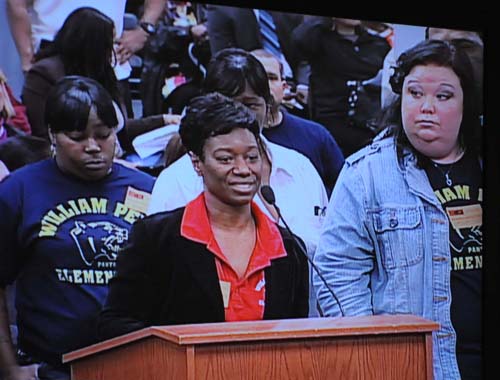 Surrounded by parents and teachers from Penn Elementary School, Penn principal Sherryl Moore-Ollie (above, at podium) once again explained how the KIPP Ascend charter school that had been placed inside Penn two years ago continued to disrupt Penn with demands for more and more space that Penn did not have. Substance photo by George N. Schmidt.Dr. Sherryl Moore-Ollie, principal of Penn Elementary School, returned to the Board to continue documenting the problems her public schools was having with the KIPP charter school which was inside her building and trying to take over the rest of it. She said that KIPP, which is sharing space at Penn, wants four more rooms in 2012, but that Penn doesn't have the rooms to spare. Penn has made accommodations for Penn, but now KIPP wants another building for KIPP primary.
Surrounded by parents and teachers from Penn Elementary School, Penn principal Sherryl Moore-Ollie (above, at podium) once again explained how the KIPP Ascend charter school that had been placed inside Penn two years ago continued to disrupt Penn with demands for more and more space that Penn did not have. Substance photo by George N. Schmidt.Dr. Sherryl Moore-Ollie, principal of Penn Elementary School, returned to the Board to continue documenting the problems her public schools was having with the KIPP charter school which was inside her building and trying to take over the rest of it. She said that KIPP, which is sharing space at Penn, wants four more rooms in 2012, but that Penn doesn't have the rooms to spare. Penn has made accommodations for Penn, but now KIPP wants another building for KIPP primary.
She said we now have no available classrooms, adding that the situation was unfair, discriminatory, and unjust. What observers have been calling "charter school imperialism" has been growing in Chicago as the Board of Education squeezes regular schools out of public buildings (many of which have been recently renovated after years of neglect) and then gives the buildings to charter schools, many of which, like KIPP, are operated by private corporations. Substance's coverage of the KIPP attack on Penn schools has been ongoing.
On URL for those who can't access the hotlink above is at:
http://www.substancenews.net/articles.php?page=1414§ion=Article
Corrie O'Connor, a Special Education teacher at Penn, remarked that Charter Schools are not upholding Federal Laws, which they are required to do because they are taking public funds. She added that KIPP can kick a child out of school.
In an unusual announcement, CEO Mazany said that his administration had arranged for "mediation" about the conflicts at KIPP. Amid some laughter from Penn supporters, who had come out in large numbers, Mazany discussed what he meant. He said, " We want to determine the results from that remediation" before going further.
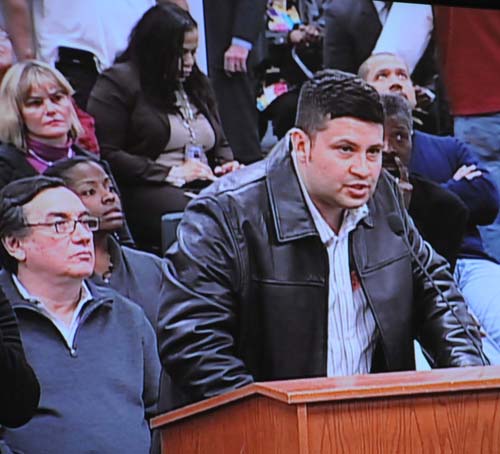 Paul Garza, whose son attends Kinzie Elemntary School, joined with his wife in trying to explain to the Board how the special needs of his child were being ignored by CPS. Substance photo by George N. Schmidt.Criticisms of the problems with how CPS is serving children with special needs continued. Patricia and Paul Garza, parents of a son in a Special Education Kindergarten program for non-verbal, sign-language students at Kinzie School, said his son was going to be transfered and asked what resources do I need for my son to remain at Kinzie. He added that when I come to these meetings and hear about Special Education, I see it's not so special.
Paul Garza, whose son attends Kinzie Elemntary School, joined with his wife in trying to explain to the Board how the special needs of his child were being ignored by CPS. Substance photo by George N. Schmidt.Criticisms of the problems with how CPS is serving children with special needs continued. Patricia and Paul Garza, parents of a son in a Special Education Kindergarten program for non-verbal, sign-language students at Kinzie School, said his son was going to be transfered and asked what resources do I need for my son to remain at Kinzie. He added that when I come to these meetings and hear about Special Education, I see it's not so special.
President Richardson-Lowry said this is the first time we are hearing of this (the Special Education situation described by Mr. Garza at Kinzie). She said Dr. Smith will meet with the parents.
The next speakers took issue with the claims by Mazany that the "breakfast in the classroom" program was a good thing.
Cindi Sodolski-Bell spoke of the danger of food allergies presented by Breakfast in the Classroom. She remarked that CPS is creating a hazardous environment for children with allergies. She stated that the classroom is not an allergy-free zone because of Breakfast in the Classroom.
Marie Mikel, of Hawthorne Academy, talked about the length of the school day. She said it is possible to have breakfast before school starts (for children who come on the bus, for example) but Breakfast in the Classroom will mean all students will wait till 9 A.M. to eat. In Hawthorne, Kindergarten students begin eating lunch at 10:45.
Board member Dr. Tariq Butt quoted Food Depository statistics at this point and remarked that children with allergies are subject to exposure to allergens outside of school as well. Butt ignored the question raised by the parents about why the "breakfast in the classroom" program couldn't take place prior to the beginning of the instructional day, and in lunchrooms with trained lunchroom staff.
CEO Mazany remarked that the overriding needs of the District have to be met, implying again that the "overriding need" was to serve a ten-minute breakfast in classrooms, rather than give the children breakfasts in lunchrooms and with more time.
The opponents of Breakfast in the Classroom were met by supporters. Liliana Hernandez, a parent and LSC member — and a member of Parents United for Healthy Schools — spoke in support of Breakfast in the Classroom. She remarked that "No one is late anymore!"
Debra Stanford also supports Breakfast in the Classroom. She said that she is a former teacher who taught for ten years in the Chicago Public Schools and presently works in the Auburn-Gresham community. She stated that the program is economic and leads to academic and behavior improvement.
Dr. Christopher Dignam, an assistant principal at Lane Tech, expressed the wish that Lane Tech High School become an academic center that admits seventh and eighth students to an accelerated program at Lane. [The Board approved it later in the meeting].
Shawn Gowder of Barton Elementary School began his remarks with the words, "I'm back!" He is on the LSC at Barton School. He began by reminding the members of the Board that he had brought the problems we was returning with to their attention almost a year ago, and that nothing had been done. He mentioned that the school is on probation and that the SIPPA and the budget goes to the CEO, but they have gotten no answers on this issue. He asked that an investigation determine if parents (at the school) are really parents.
Chief Counsel Patrick Rocks said this would be referred to the Inspector General.
Another challenge to CPS policies came from students who wish to make full use of the Internet. Jesus Martinez, of the Mikva Challenge Education Council, said he was blocked from reading an article on YAHOO. He also asked that the CPS provider be changed from First Class.
Student Mercedes Sivels, also of the Mikva Challenge Education Council, wants teachers to have access to You-Tube. Presently, it is blocked. She said the new policy is supposed to be on the Board agenda in April. She added that she goes to a charter school with access to You-Tube. She asked that the Board please pass new policies in April.
CEO Mazany expressed admiration for the Mikva Challenge Education Council. But he did not explain why CPS students (and teachers) continue to be blocked from accessing You Tube and other Internet locations where major learning materials are available.
Katie Bordner, a teacher at North Lawndale Prep, detailed how students are using technology and went into great detail about what they could do utilizing computers from their schools if they weren't blocked by CPS policies.
Lynette Reyes, of Penn Elementary Bilingual Education, asked who will service these bilingual students if KIPP continues to expand? She added public schools service all students.
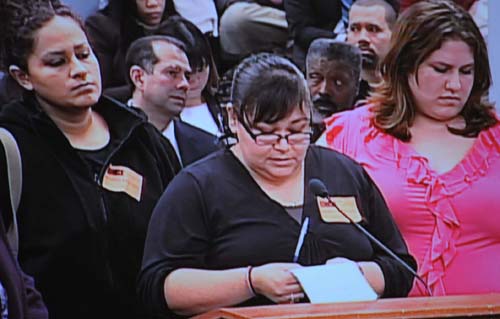 Delores Reyes, chairperson of the Avondale LSC, told the Board that the proposal to put Avondale and Logandale together was ridiculous and would hurt the children from both schools. Opposition in the community to the proposal is strong. Substance photo by George N. Schmidt.Dolores Reyes, an LSC chairperson, spoke against Avondale consolidating with Logandale Middle School. Avondale pre-schoo alonel now has140 students enrolled, she said, and the proposed "consolidation" just doesn't make sense to anyone in the schools or the community. Many suspected that the consolidation proposed by Mazany was to open the door to a charter school occupying one of the two buildings.
Delores Reyes, chairperson of the Avondale LSC, told the Board that the proposal to put Avondale and Logandale together was ridiculous and would hurt the children from both schools. Opposition in the community to the proposal is strong. Substance photo by George N. Schmidt.Dolores Reyes, an LSC chairperson, spoke against Avondale consolidating with Logandale Middle School. Avondale pre-schoo alonel now has140 students enrolled, she said, and the proposed "consolidation" just doesn't make sense to anyone in the schools or the community. Many suspected that the consolidation proposed by Mazany was to open the door to a charter school occupying one of the two buildings.
Josefina Rojas also spoke against consolidation. She said that Avondale is a K-5 school that has 724 students. Logandale Middle School, which has a capacity of 690 students, has 255 students. She remarked that no rooms suitable for Pre-K are available in Logandale. She added that in the past, Avondale was on probation for one year and Logandale Middle School was on probation for three years.
President Richardson-Lowry asked CEO Mazany to have what she has recently been calling a "carve-out" session. CEO Mazany replied that it will be one campus.
Long time southwest side community activist Alfred Rodgers asked for the sharing of information of Area 20. He said it is time for transparency. He mentioned that we're going through the principal selection process. He asked who owns the property at 75th and Homan and added "Welcome aboard, Buddy" to Chief Education Officer Charles Payne.
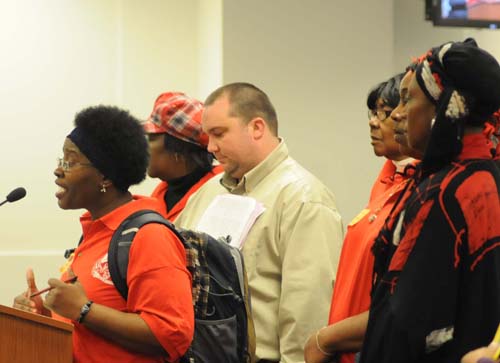 Freida Dunn of Cather Elementary School opposed the consolidation of Cather and Beidler so that CPS can turn the Beidler building over to the much hyped "Urban Prep" charter school. Substance photo by George N. Schmidt.No sooner had Rodgers finished than another challenge to consolidation came before the Board. Frieda Dunn, a chairperson at Willa Cather Pre-K to 8, is against the merger with Beidler. She asked the Board, "Do not Fannie Mae us." She said that we have teachers who are surrogate parents, we do not want to be homeless, and added that our children have to go through three gang areas to get to Beidler.
Freida Dunn of Cather Elementary School opposed the consolidation of Cather and Beidler so that CPS can turn the Beidler building over to the much hyped "Urban Prep" charter school. Substance photo by George N. Schmidt.No sooner had Rodgers finished than another challenge to consolidation came before the Board. Frieda Dunn, a chairperson at Willa Cather Pre-K to 8, is against the merger with Beidler. She asked the Board, "Do not Fannie Mae us." She said that we have teachers who are surrogate parents, we do not want to be homeless, and added that our children have to go through three gang areas to get to Beidler.
Christ Kroger, a teacher of many years at Cather, is against consolidation with Beidler. He said Urban Prep wants the building. He added that we're off probation because of dedicated faculty and students. He remarked that we are a success story and will be harmed if we're removed.
Bobbie Townsend, of Dyett School, told of homeless children in the school. She asked for donations of articles and time, but not money. She also asked for an auditorium at Dyett. She offered the mottos "Reach Out - Give a Hand" and "Reach One - Teach One."
Jose Hernandez, of Parents United for Healthy Schools and a PIAB chairperson, said a quorum is needed and the process to select members needs to be changed. Chief Counsel Patrick Rocks replied that this has been an issue for over a year and we need good representation.
Diondai Brown-Whitfield, an alumna of Austin High School, now celebrating its 120th anniversary celebration, wants Austin to be designated as a historical landmark. She said the school began in the mid 1880s. She added that many notable people graduated from Austin High School. She also wants to be involved in honoring Oprah Winfrey.
Jerry Travlos, Smyser Principal, spoke of overcrowding and asked that Smyser be made a priority. Over one thousand students are enrolled, thirty-seven or more students are in classrooms that measure 200 square feet. He said it is a high-achieving neighborhood school and asked that the boundaries be adjusted. He added that a magnet school and a charter school are nearby, but didn't name them. One of the problems in the area around Smyser has been that more than ten years ago, the Board of Education created the "Chicago Academy" in the old Wright College building at Austin and Roscoe, thereby depriving the growing community of the massive amount of space available at the Wright site. Instead of devoting the public building to the neighborhood schools, which were becoming more and more overcrowded, CPS gave Wright to the "Chicago Academy," the project of the Academy for Urban School Leadership, then operated by venture capitalist Martin Koldyke. Presently, the largest amount of available public school space in the Smyser area is inside the Chicago Academy space, but Smyer and others are targeting nearby O.A. Thorp school instead of the privileged Chicago Academy for relief of the overcrowding.
Travlos refused to be interviewed by Substance for this article.
President Richardson-Lowry told Travelos that the boundary issues will be an item on the agenda next month. She added that too many people want to come to a good thing.
It was now 1:35 P.M.
Norma Brown, a CPS employee who suffered an employment loss, said that you have shown me nothing but disdain. She remarked that she was beaten by three students, who then received two week suspensions. She was then put in a pool of teachers, substituting after teaching thirty-two years. She has been flagged not to hire and told to go to a school and be a sub for a day. She said that you took my tenure and sick days and added "I want something to be done."
CEO Mazany told her to meet with Debbie Gray of the District.
No sooner had Norma Brown been put aside by Mazany, again, than the charter schools invasion of the regular public schools was once again back on the agenda, this time from the city's southwest side. Joann Williams, who said she graduated from Hearst Elementary, asked for a delay until members of the community adjacent to Hearst are informed. She said, "No one from my neighborhood knew about petitions, but the Academy for Global Citizenship (AGC) did." She added that because the McClurg Courts Public Housing closed, the Hearst School Annex is empty, but that when the housing projects reopen, the public school will once again need the annex space.
Sarah Ippel, head of the "Academy for Global Citizenship" (AGC) charter school, was next. She said the parents are enthusiastic about and seek approval of AGC in the vacant Hearst Annex. She added some statistics she claimed demonstrate the desire on the community for AGC.
Andrew Broy, President of the Illinois Network of Charter Schools, sought to clarify charter school enrollment. He said that charter schools have to serve Special Education students and cannot waive Federal regulations, ignoring several months of information that have been presented to the Chicago Board of Education to the contrary. He added he supports a comprehensive solution for Penn/KIPP.
Next, the scene shifted to another conflict between a charter school and a regular public schools.
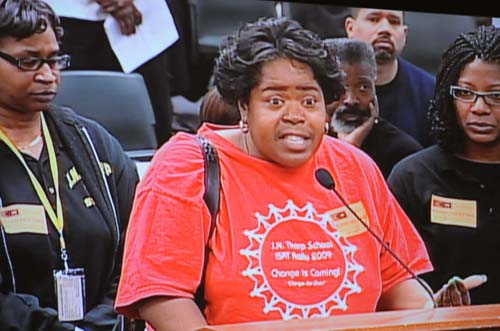 J.N. Thorp teacher Dortheia Goodrum described in heartbreaking detail how the second class citizenship of the Thorp students resulted in their having to go a block to the washroom since the LEARN charter school occupied Thorp and began discriminating against the children from the regular public school, which is located on Chicago's southeast side. Substance photo by George N. Schmidt.Dortheia Goodrum, a teacher, spoke of the attendance problems caused by the recurring problem of cold in the old J. N. Thorp building, on Chicago's southeast side. Staff and community leaders from J.N. (not to be confused with O.A.) Thorp have been relegated to the status of second class citizens in their own building since CPS began expanding charter schools in that part of the city through the Office of New Schools. Presently, the most desirable portions of Thorp are going to the LEARN charter school.
J.N. Thorp teacher Dortheia Goodrum described in heartbreaking detail how the second class citizenship of the Thorp students resulted in their having to go a block to the washroom since the LEARN charter school occupied Thorp and began discriminating against the children from the regular public school, which is located on Chicago's southeast side. Substance photo by George N. Schmidt.Dortheia Goodrum, a teacher, spoke of the attendance problems caused by the recurring problem of cold in the old J. N. Thorp building, on Chicago's southeast side. Staff and community leaders from J.N. (not to be confused with O.A.) Thorp have been relegated to the status of second class citizens in their own building since CPS began expanding charter schools in that part of the city through the Office of New Schools. Presently, the most desirable portions of Thorp are going to the LEARN charter school.
Goodrum said that there is one set of bathrooms in the middle of the building for the 500 students from the real public schools. She said this has been leading to a loss of instructional time and other bathroom problems for the students because they must use bathroom facilities in another building — a walk of a city block. She added that the school went off probation in 2009-2010, there are no coatrooms in six classrooms, and that a heated floor and washrooms are in the adjacent building.
Joseph Zrnchik, the Thorp PE teacher who has been with the CPS for 25 years, said J. N. Thorp was never provided with the kind of equipment that a charter school has. He spoke of when public education first began in Chicago and remarked about the numerous empty rooms in the charter school.
President Richarson-Lowry asked the Thorp people to meet with Operations Chief Pat Taylor to develop a plan to resolve the issues regarding bathrooms. Observers noted that this was the fourth or fifth time that Richardson Lowry had sent a group from Thorp to Pat Taylor since the controversy over the charter school began less than two years ago.
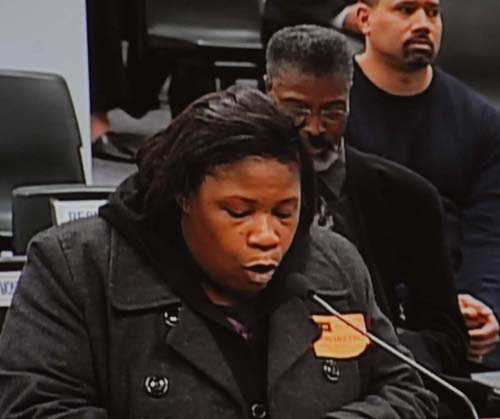 Janeen Vaughn told the Board how the Galapagos Charter School mistreated her young son, labeling him for "sexual harassment" in second grade, and the impact of the treatment on the child. She said that her son is now in a regular public school, and asked the Board why CPS promoted the charters without telling parents the kinds of treatment the children may receive. Substance photo by George N. Schmidt.Janeen Vaughn spoke of issues at Galapagos charter School on the city's west side. She said her son, in second grade, was accused of "sexual harassment" at the charter school, was said to have behavioral problems, and the teacher spoke to him inappropriately. DCFS spoke to the family. He was suspended four times at the charter, and finally was put out. She added that her son never had problems at other schools, that he is now at Cameron School, and that he is not a behavior problem, but is academically behind. She had three questions for the Board: Will you fix the problem? Why do you promote charter schools? And she asked if someone could speak with her. Someone was sent to speak with her.
Janeen Vaughn told the Board how the Galapagos Charter School mistreated her young son, labeling him for "sexual harassment" in second grade, and the impact of the treatment on the child. She said that her son is now in a regular public school, and asked the Board why CPS promoted the charters without telling parents the kinds of treatment the children may receive. Substance photo by George N. Schmidt.Janeen Vaughn spoke of issues at Galapagos charter School on the city's west side. She said her son, in second grade, was accused of "sexual harassment" at the charter school, was said to have behavioral problems, and the teacher spoke to him inappropriately. DCFS spoke to the family. He was suspended four times at the charter, and finally was put out. She added that her son never had problems at other schools, that he is now at Cameron School, and that he is not a behavior problem, but is academically behind. She had three questions for the Board: Will you fix the problem? Why do you promote charter schools? And she asked if someone could speak with her. Someone was sent to speak with her.
Mary Stephenson-Schroeder said her son, Jonathan Schroeder, cannot go to Kindergarten next year because of a lack of flexibility in the CPS policy. He was born in the late summer and will be six in August. Under the state law, a child must be a least five by September first for Kindergarten, but she said a maximum age is not mentioned. She held her child back on purpose because he would have been a young five in Kindergarten. Now, she has been told he must be enrolled in first grade instead of Kindergarten. She wanted to know what the basis for this policy is and what law is it based on. She said this policy disregards a child's maturity level. She asked where she can send her child for Kindergarten.
 The right wing ideology followed by all seven members of the Chicago Board of Education and the executives of Chicago's public schools owes more to the pseudo-philosophy of Ayn Rand and the bulbous novel "Atlas Shrugged" than to anything resembling classical political or economic thought. And it is no coincidence that the offices of "John Galt Solutions" (above) at on the 19th floor of CPS headquarters in Chicago. Substance photo by George N. Schmidt. Chief Counsel Patrick Rocks responded that his office will send her a letter and all will be resolved in the next few months.
The right wing ideology followed by all seven members of the Chicago Board of Education and the executives of Chicago's public schools owes more to the pseudo-philosophy of Ayn Rand and the bulbous novel "Atlas Shrugged" than to anything resembling classical political or economic thought. And it is no coincidence that the offices of "John Galt Solutions" (above) at on the 19th floor of CPS headquarters in Chicago. Substance photo by George N. Schmidt. Chief Counsel Patrick Rocks responded that his office will send her a letter and all will be resolved in the next few months.
President Richarson-Lowry added that exceptions have come up and mentioned a Blue Ribbon Committee for additional recommendations. (The Blue Ribbon Committee was also mentioned by Chief Counsel Patrick Rocks.)
Bert Murrell spoke of the effective use of money and funding. He wanted to know how effective is a school improvement plan and asked if there is a secret policy that kids can't take books home. To Chief Counsel Patrick Rocks, he said fund-raising has gotten out of hand, for example jeans day, and said there should be no slush funds in the general fund.
Gemini Mittenthal, an LSC chair at Frederick Stock Early Childhood Center, where there are 300 three-to-four year olds, said they use hands-on instruction. She added that her son will be narrator for a student-designed program.
President Richardson-Lowry remarked that attorneys from her firm read to the students and "it makes them better people." It was not clear if she meant the attorneys or the students became "better people." Perhaps both.
Joyce Chapman said Wendell Smith School, which was designed by a Japanese architect, was the first school to be put in educational crisis. She said she is a proponent of closing schools. She told CPS that it was a nuisance to Wendell Smith, that the school is under capacity and under-utilized, and that CPS should take a tour.
President Richardson-Lowry asked the Chief Area Officer (CAO) Linda Williams to speak to this person.
Robert Douglas, of Roseland, who said that over 50 percent of the public schools in that community were under-utilized and successful educational institutions were needed.
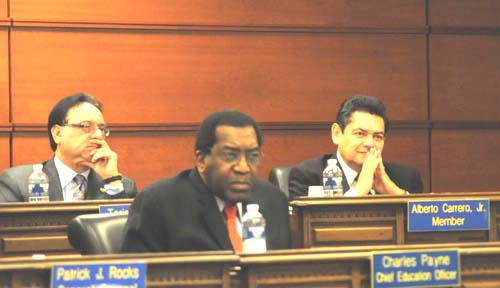 Despite the fact that he does not have an Illinois Type 75 administrative certificate, Charles Payne (above, center) became Chief Education Officer of CPS at the March 2011 Board meeting. For more than a decade, Chicago has acted as if a University of Chicago stamp of approval (Payne teaches at the U of C) was superior to Chicago public schools experience or Illinois certification. Substance photo by George N. Schmidt.Wanda Hopkins welcomed Dr. Charles Payne and told him we need schools for students that disrupt and added that children are kicked out of charter schools.
Despite the fact that he does not have an Illinois Type 75 administrative certificate, Charles Payne (above, center) became Chief Education Officer of CPS at the March 2011 Board meeting. For more than a decade, Chicago has acted as if a University of Chicago stamp of approval (Payne teaches at the U of C) was superior to Chicago public schools experience or Illinois certification. Substance photo by George N. Schmidt.Wanda Hopkins welcomed Dr. Charles Payne and told him we need schools for students that disrupt and added that children are kicked out of charter schools.
Chief Education Officer Payne said we need to think about the most vulnerable in the system.
Sylvester Hendricks asked for a moment of silence for our assassinated brothers from Jesus Christ to Michael Wayne Scott. He had intended to announce that this May would be his last Board meeting after twenty years, but he said he feels that there is still a need for his advocacy. He mentioned that a student told him he would not be allowed to speak before the Board and would be arrested if he continued to press for this.
With this, public participation ended. The Board went into closed session at approximately 2:30 P.M.
Comments:
By: The Retired Principal (RP)
Bowen's Public Hearing
Does anyone know when Bowen's public hearing for consolidation will be?
By: xian
Look out!
I think that Ren2010 Walgreens truck is trying to run over the protesters!
By: BrandonBag
fusion herbal incense
thyroid homeopathic remedies https://forums.dieviete.lv/profils/127605/forum/ alternative remedies


By: Jean Schwab
Scammon School teachers
I was affended by the two teachers who spoke at the Board meeting about three E-3 teachers harrassing their school. I was affended by what they did not mention such as the number of staff that have left Scammon since Weaver became principal and started to clean house. It is natural that parents and staff would become upset when they see long time, effective staff leaving their school. Last June 16 teachers were let go. That is an indication that something is terribly wrong and it isn't the three - E3 teachers.